(CNN) — On the shoreline of the Dead Sea, Jordanian comedian and national treasure Nabil Sawalha strides chest-deep into the water, with all the confidence of a swan to a lake.
“It loves you, the water here, it hugs you,” he says as he allows the sea to collect his legs and buoy his entire body to the surface.

“It’s very sad.” Jordanian comedian Nabil Sawalha laments the Dead Sea’s decline.
The playwright, director and actor has taken the day to travel from his home in Amman down to the lowest point on the planet’s surface to experience the mineral-rich waters nestled between Jordan and Israel.
“Nowhere in the world can you just sit on the water and feel relaxed and feel happy,” Sawalha says while enjoying his dip.
The Dead Sea is one of the saltiest bodies of water on the planet, with around 34% salinity. Its name in Hebrew translates as the Salt Sea.
But the Dead Sea is dying, its waters vanishing at an alarming rate. With each passing year, the possibility of enjoying a visit to its shores keeps receding.
“It’s sad, very sad,” Sawalha says, lamenting how significantly the water level has dropped in the past 15 years.

A view of the current shoreline of the Dead Sea shows where water levels have dropped over the years.
The Dead Sea is fed from natural sources, primarily the Jordan River and its basin, but some of those it relies on have been either dammed or diverted.
Meanwhile Dead Sea minerals, highly prized for their therapeutic properties, are being extracted, further contributing to the sea’s shrinking.
Jordan woos tourist flow after arrivals ebb

Jordan’s visitor numbers have fallen sharply in recent years.
AHMAD ABDO/AFP/AFP via Getty Images
Not unlike the Dead Sea, Jordan’s tourist numbers had been drying up in the last decade before almost evaporating during the Covid pandemic.
In 2020, tourism revenues fell to $1.4 billion, a fall of 76% on the previous year, according to the UN World Tourism Organization.

Nayef Al-Fayez, Jordan’s tourism minister, says his country is on the vacation comeback trail.
Lloyd Sturdy/WTM
The country’s tourism minister, Nayef Al-Fayez, used the recent World Travel Market trade event in London to trumpet Jordan’s push for more visitors.
Landscapes worthy of the big screen

Jordan’s otherworldly Wadi Rum desert has been the backdrop for several big-budget Hollywood films.
CNN
There is no doubt that Jordan’s epic landscapes and archaeological sites are a major tourist attraction. In fact, they’re used regularly by filmmakers from Amman to Hollywood as otherworldly backdrops.
Most recently, sandy sci-fi blockbuster “Dune” was filmed in Jordan’s Wadi Rum desert. Films such as the live-action adaptation of Disney’s “Aladdin” and “Star Wars: Rogue One” were also shot on location in the desert plains in the country’s south.
Prince Ali Bin Al Hussein, half-brother to King Abdullah II, is the chairman of Jordan’s Royal Film Commission. Among many functions, it’s responsible for attracting big-name studios to Jordan — as well as fostering local talent and experience.

Richard Quest sits by a campfire with Prince Ali Bin Al Hussein of Jordan in his country’s Wadi Rum desert.
CNN
“It’s important that we are developing our own film industry and it brings real benefits to people. It’s not about getting support or money into government. It’s about the people who work on the ground, the local communities all benefit from this wonderful industry,” Ali says.
“It’s a beautiful place. People want to see, they want to visualize, they want to understand what’s going on.”
Rediscovering Jordan’s lost city
Professor Sami Alhasanat, a proud Petraen, is our guide through this red-rose Jordanian city “half as old as time”.
About two hour’s drive from Wadi Rum is arguably Jordan’s most iconic tourist attraction: the ancient city of Petra.
The Nabataean civilization carved the city out of rock to create their capital over roughly 500 years from the fourth century BCE onward. Nomadic tribes turned traders, they settled in the area to control trade routes, offer security, and collect taxes and tolls.
Today, there’s only one way into the archaeological wonder — through the winding rock canyon known as the Siq. The Nabataeans used the elevation of the canyon to create aqueducts to channel water down to the city below.
The journey through the Siq takes about 40 minutes by foot. At the end of it, the narrow canyon opens into a massive clearing — revealing Petra’s most famous facade, The Treasury, a towering structure carved into the cliff side. The wonderment of it hits you like a slap in the face.

Petra’s ancient Treasury established it as the capital city of the Nabataeans.
MENAHEM KAHANA/AFP/AFP via Getty Images
Proud Petrean and professor at the Al-Hussein Bin Talal University, Sami Alhasanat insists this was no mistake.
“Location, location, location — this is what it was meant to be,” he says. “To be very impressive. It is to give you the first impression of ‘This is who we are.’ Just right by the main entrance, when you first encounter the Treasury, you get this impression that this is a great civilization.”
Despite growing up in Petra and dedicating his career to sharing its significance with others, Alhasanat says the UNESCO World Heritage site still astounds him.

Professor Sami Al Hasanat from the Al-Hussein Bin Talal University is a proud Petraen who has dedicated his career to sharing his childhood “playground” with the world.
Alasdair Skene
“It’s still impressive for me. Every day I see differently. To me it seems like concentrating on a picture. The more you focus, the more you see, the more you’ll discover this is a treasure. This place connects modern days with the past and future,” he says.
Petra was forgotten by the outside world for 1,000 years until Europeans came digging in 1812 and unearthed its magnificent structures.
While the trade-savvy Nabataeans are no more, their descendants are still waiting to welcome visitors to Petra.

Bedouin tour guides work within Petra.
Leroy Ah Ben
Bedouin guides vie for the business of tourists as they spill out from the Siq. They offer donkeys and camel rides, personal tours and photographer services for those wanting to capture the moment for social media.
Mostly dressed in darkly colored Western clothes, but still capped with traditional Jordanian shemagh or keffiyeh scarves, the Bedouins of Petra are unmistakable. But it is something they wear on their face that is somehow the most noticeable.

Petra’s Bedouin say they wear kohl, a type of eyeliner, to protect their eyes from the harsh sun and sand.
Leroy Ah Ben
It’s dark eyeliner or Arabic kohl — a way the Bedouins protect their eyes from the sun, the dust and the sand. “This is our sunglasses,” one guide remarks. “I put it on you?” he offers.
Altogether it gives them a look straight out of “Pirates of the Caribbean” — although they insist they were first. “No, not Jack Sparrow. He take our style, my friend!” another laughs.
That Bedouin charm takes Petra from being a cold ancient ruin to a living, breathing city. And that warmth, good spirit and hospitality that thrives in this land as old as time is exactly what Jordan believes will call people to explore once again.
